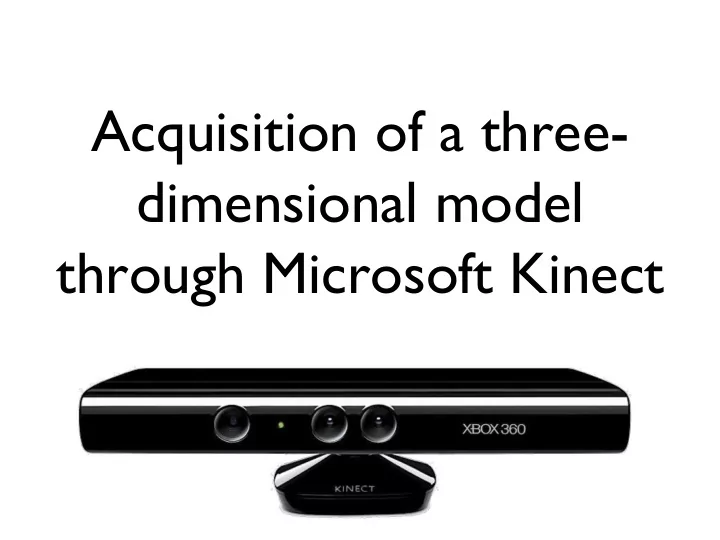

Acquisition of a three- dimensional model through Microsoft Kinect
The Microsoft Kinect • RGB camera sensor • IR projector and sensor • Microphones array • Three axis accelerometer
The Microsoft Kinect 30 fps: � RGB: 640 x 480 pixels; 24 bits. � Depth: 320 x 240 pixels; 11 bits.
The Point Cloud Library The Point Cloud Library (PCL) is a standalone, large scale, open project for 2D/3D image and point cloud processing, released under the terms of the BSD license, and thus free for commercial and research use.
The Point Cloud Library � filtering � feature estimation � surface reconstruction � registration � segmentation
The process workflow • data acquisition • data elaboration
Data acquisition
Data elaboration Step 1: outliers removal. StatisticalOutlierRemoval uses point neighborhood statistics to filter outlier data. The algorithm follow this steps: - compute the average distance that each point has to its nearest k neighbors. - threshold: mean + multiplier*standard_deviation. - classify each point as inlier or outlier.
Data elaboration Step 1: outliers removal. StatisticalOutlierRemoval uses point neighborhood statistics to filter outlier data. The algorithm follow this steps: - compute the average distance that each point has to its nearest k neighbors. - threshold: mean + multiplier*standard_deviation. - classify each point as inlier or outlier.
Data elaboration Step 2: downsampling. VoxelGrid creates a 3D voxel grid over the input point cloud data. Then, in each voxel, all the points present are approximated with their centroid.
Data elaboration Step 3: smoothing. MovingLeastSquaresOMP is a performance oriented class implementing the MLS algorithm used for smoothing surfaces.
Data elaboration Step 4: surface normal estimation. NormalEstimationOMP estimate surface normal of a point from the surrounding point neighborhood support of it, enclosed in a predefined radius.
Data elaboration Step 5: keypoints detection. A keypoint is simply a point that has been identified as a relevant in some way. A good keypoint detector will find points which have the following properties: • Sparseness; • Repeatiblity; • Distinctiveness.
Data elaboration Step 5: keypoints detection. SIFTKeypoint finds local extrema in a difference-of- Gaussians (DoG) scale-space computed based on several parameters: • the size of the smallest scale; • the number of times the scale doubles; • the number of scales in between each doubling; • the minimum absolute DoG value needed to qualify as a keypoint.
Data elaboration Step 6: features estimation. FPFHEstimationOMP attempts to capture as best as possible the sampled surface variations by taking into account all the interactions between the directions of the estimated normals.
Data elaboration Step 7: initial alignment. It computes the rotation-traslation matrix to find the absolut minim using the RANSAC algorithm.
Data elaboration RANdom SAmple Consensus. Iterative, non-deterministic, method to estimate parameters of a mathematical model from a set of observed data. Assumption: data contains inliers + outliers and noise. Two phases: - hypothesis generation; - hypothesis evaluation.
Data elaboration Step 7: initial alignment. Steps: 1- extract P points from the N cloud features; 2- search the same P features in the N-1 cloud; 3- compute an RT matrix; 4- compute the FitnessScore (the error). The previous steps are repeated several times and the best RT matrix is chosen.
Data elaboration Step 7: initial alignment. RANSAC Pros and Cons: + Robust estimation; - No time limit; - Many iterations; - Setting thresholds.
Data elaboration Step 8: refining initial alignment. IterativeClosestPoint class provides a base implementation of the ICP algorithm. The aim is to find transformation matrix associated to the rigid transformation of the cloud.
Data elaboration Step 8: refining initial alignment. Starting from initial guess ICP iterate this steps: - compute the cloud P transormation using a RT matrix; - for each point on M, find closest point on P .
Data elaboration Step 8: refining initial alignment. The algorithm has several termination criteria: - Number of iterations; - Difference between the previous and the current transformation is smaller than a user defined value; - The sum of euclidean squared errors is smaller than a user defined threshold.
outliers frame capture downsampling smoothing removal local surface normal keypoints descriptors initial aligment estimation detections computation refine initial clouds alignment transformation
Next.. - CUDA feature extraction; - surfaces estimation; - objects segmentation; - objects detection and exportation.
PROCESSING TOPIC PAPER PHASE Preprocessing Statistical Outlier Removal (Noise) R. B. Rusu, Z. C. Marton, N. Blodow, M. Dolha, and M. Beetz. Towards 3D Point Cloud Based Object Maps for Household Environments Robotics and Autonomous Systems Journal (Special Issue on Semantic Knowledge), 2008. Voxel Grid Filtering (Downsampling) - - CUDA feature extraction; - surfaces estimation; Smoothing Shachar Fleishman, Daniel Cohen-Or, Claudio T. Silva Robust Moving Least-squares Fitting with Sharp Features - objects segmentation; Initial Alignment SIFT Detector David G. Lowe, "Distinctive image features from scale-invariant - objects detection and exportation. keypoints," International Journal of Computer Vision, 60, 2 (2004), pp. 91-110 SIFT Descriptor - R.B. Rusu, N. Blodow, M. Beetz. “Fast Point Feature Histograms (FPFH) for 3D Registration.” In Proceedings of the IEEE International Conference on Robotics and Automation (ICRA), Kobe, Japan, May 12-17 2009. - R.B. Rusu, A. Holzbach, N. Blodow, M. Beetz. Fast Geometric Point Labeling using Conditional Random Fields. In Proceedings of the 22nd IEEE/RSJ International Conference on Intelligent Robots and Systems (IROS), St. Louis, MO, USA, October 11-15 2009 RANSAC Fast Point Feature Histograms (FPFH) for 3D Registration," Rusu et al. Refine Alignment Iterative Closest Point Paul J.Besl, Member, IEEE, and Neil McKay A Method for Registration of 3-D Shapes
Recommend
More recommend